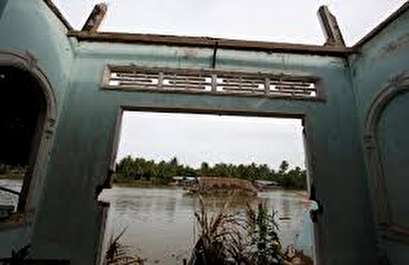TEHRAN, Jan 15 -In the dead of night, the entire front half of shopkeeper Ta Thi Kim Anh’s house collapsed. Perched on the sandy banks of the Mekong River, it took just a few minutes for one half of everything she owned to plunge into its murky depths.
 TEHRAN, Young Journalists Club (YJC) -In the dead of night, the entire front half of shopkeeper Ta Thi Kim Anh’s house collapsed. Perched on the sandy banks of the Mekong River, it took just a few minutes for one half of everything she owned to plunge into its murky depths.
TEHRAN, Young Journalists Club (YJC) -In the dead of night, the entire front half of shopkeeper Ta Thi Kim Anh’s house collapsed. Perched on the sandy banks of the Mekong River, it took just a few minutes for one half of everything she owned to plunge into its murky depths.
“Our kitchen, our laundry room, our two bedrooms, all gone,” said Kim Anh, speaking amongst the twisted metal and rubble of her house, from which she still sells eggs, soap and instant noodles to villagers in Ben Tre, a province in Vietnam’s Mekong Delta region.
“We’d be better off living in a cave instead,” said Kim Anh, who has used coconut husks and old tires to reinforce the riverbank under her home.
Upstream damming and extensive mining of the Mekong’s riverbed for sand is causing the land between the sprawling network of rivers and channels near the mouth of one of the world’s great rivers to sink at a pace of around 2 cm (0.75 inches) a year, experts and officials said.
The 4,350 km (2,700-mile) river, known as the Lancang in its upper reaches, flows from China’s Tibetan Plateau along the borders of Myanmar, Laos and Thailand, through Cambodia and finally Vietnam, where it forms the delta known in Vietnam as the “Nine Dragons”.
Reuters visited three provinces straddling different branches of the delta, where it has supported farming and fishing communities for millennia.
Across the region, local authorities are struggling with a rapid pace of erosion that is destroying homes and threatening livelihoods in the Southeast Asian country’s largest rice-growing region.
A key cause is the years of upstream damming in Cambodia, Laos and China that has removed crucial sediment, local officials and experts said.
That sediment, vital for checking the mighty Mekong’s currents, has also been lost due to an insatiable demand for sand - a key ingredient in concrete and other construction materials in fast-developing Vietnam - that has created a market both at home and abroad for unregulated mining.
“It’s not a problem of the lack of water, it’s the lack of sediment,” said Duong Van Ni, an expert on the Mekong River at the College of Natural Resources Management of Can Tho University, the largest city in the Mekong Delta region.
Source:Reuters
Related News
Your Comment